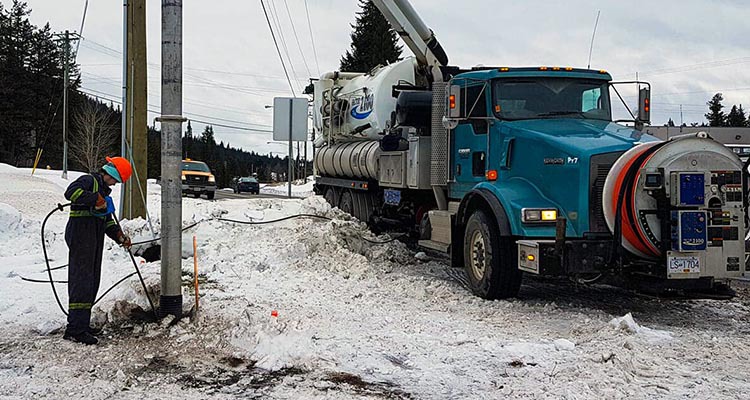
Although digging is an essential part of the human quest for progress, not all digging types are beneficial for every project. This is especially true in areas full of underground utilities, requiring specialized methods to perform excavation work safely. We can’t use conventional excavation methods to damage such utilities and, therefore, must employ advanced hydrovac excavation techniques to dig up the ground.
Hydrovac excavation is a process of digging up and evacuating soil using high-pressure water and air vacuums. Unlike traditional excavation techniques, this method of excavation is highly precise, accurate, fast and efficient.
The hydrovac excavation method utilizes an excavator truck that sends out a low, focused, and intense stream of high-pressure water, forcing the soil to break up. The slurry formed in the area is then suctioned and vacuumed by air vacuum to a tank mounted on the truck. This tank takes the debris to a designated location and dumps it there.
In the past few years, there has been an increased demand for hydrovac excavation services in Canada. Below, we have discussed the versatility of this process and its five popular applications.
Daylighting Or Potholing
Potholing or daylighting refers to the activity of exposing underground pipes and utility lines to daylight using a hydro-vacuum excavator. It is the best and safest way to expose utility lines such as gas pipes, sewer and water lines, telecommunication cables, and more without damaging them.
This application uses pressurized water and vacuum suction to excavate any soil type without damaging its surrounding areas and utility lines. Before this method, utility crossings had to be exposed by hand digging, as conventional methods would damage them. However, these methods, especially hand digging, posed a danger to workers if they accidentally hit a utility line.
This type of excavation is carried out in congested areas and is done to reduce cost and improve the process’s safety. It also significantly increases the project’s productivity as it is a much quicker way to expose the underground lines to daylight.
Slot Trenching
Slot trenching is an excavation process that involves digging very thin trenches and slots into the soil to place utility lines and underground pipes such as gas lines, water pipes, cables, conduits and more. Hydrovac excavation allows for very accurate and narrow trenches to be drilled into the ground and requires a minimum amount of backfilling.
This advanced form of excavation offers a much faster way to achieve slot trenching than manual excavation. Manual digging, on the other hand, is time-consuming and can damage underground utilities.
Debris Removal
Hydro-vacuum excavation is a cost-effective way to remove debris and clean certain areas without damaging their existing infrastructure. This method is ideal for cleaning drainage structures, utility holes, sewer lines, or catch basins that have become clogged.
Ghost Hydrovac provides affordable, reliable, and efficient flushing services for sewer lines, lift stations, and catch basins. We also provide high-pressure washing and steam cleaning services for various applications where you need dirt and grime removed. Some of the advantages of using the hydrovac technique for debris removal include:
- It can clean and flush utility lines buried hundreds of feet underground
- It can effectively remove dirt and debris around underground pipes and lines
- It offers a cost-efficient way to service and extend the lifespan of underground infrastructure, including utility lines
Cold Weather Excavation
Cold weather excavation poses many challenges for workers as they have to work in freezing temperatures to dig up the ground. Conventional digging during freezing temperatures also involves a lot of pollution. This is because the soil first needs to be thawed using cool, wood, or other chemicals before the workers can commence digging on it.
On the other hand, hydro excavation involves no pollution and uses warm water that allows the grounds soil to loosen faster. Using this process eliminates the need to expose workers to low temperatures and warm the soil with nonrenewable resources.
Pole Hole Excavation
Pole hole excavation involves installing holes for posts, poles, signs, and more. Hydrovac excavation is one of the great methods to accurately and efficiently achieve this digging task.
Holes for these items need to be of various depths and diameters. Hydro excavation uses pressurized water to create precise and narrow holes and then an air vacuum to remove dirt and debris. The precision of the hydro excavation process makes it ideal for piling hole excavation.
For more information on hydrovac excavation, visit our website or contact us today for personalized service.